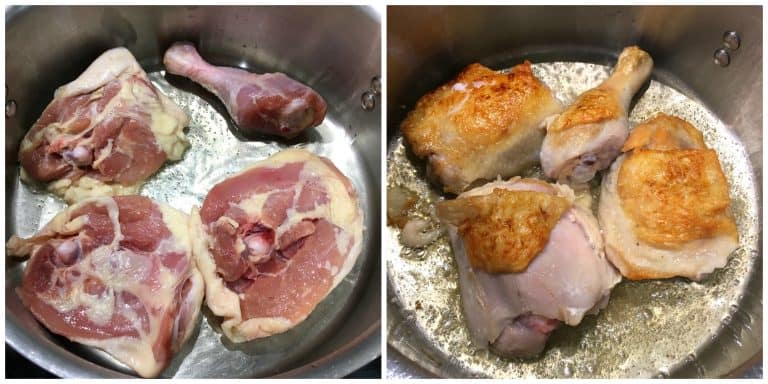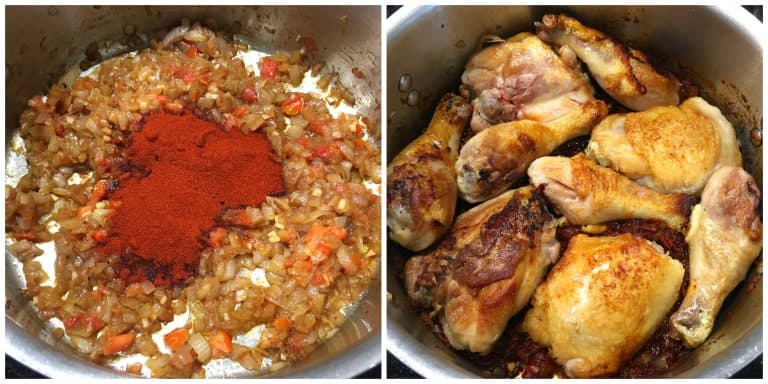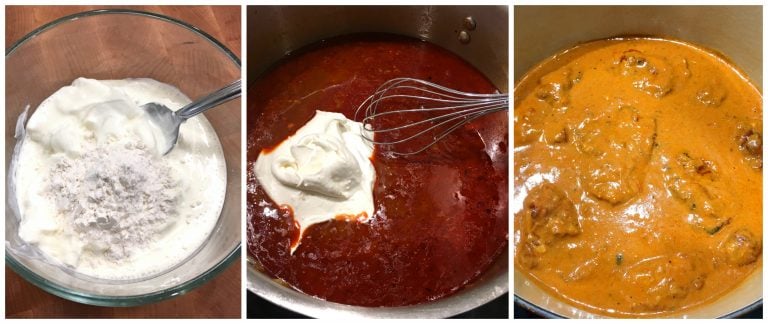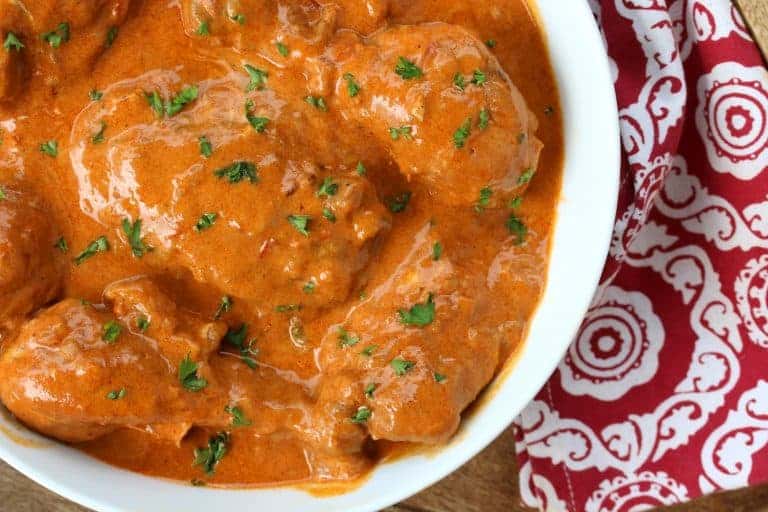Authentic Chicken Paprikash
This post may contain affiliate links. See my disclosure policy.
One of the most famous and beloved of all Hungarian dishes, this authentic Chicken Paprikash recipe features tender chicken in an unforgettably rich, flavorful and creamy paprika-infused sauce! It’s Hungarian comfort food at its tastiest and is absolute heaven on a plate!

What is Chicken Paprikash?
Chicken Paprikash, also known as Paprikás Csirke in Hungarian, is a traditional Hungarian dish that features tender chicken pieces that are cooked in a rich, flavorful and creamy paprika-based sauce and commonly served with egg noodles or dumplings. It has been enjoyed in Hungary for centuries, likely dating back to the 18th or 19th century. A reflection of the peasant origins or Hungarian cuisine, chicken paprikash was made from simple and available ingredients like chicken, onions, sour cream, and paprika. Older, tougher chicken could be utilized because the low and slow cooking time ensured tender meat and the end result was a dish that was both hearty and delicious. This is Hungarian comfort food at its best, a symbol of Hungarian culinary heritage, and has since become popular throughout the world.
Hungary is a country with beautiful landscapes, cities, villages, cultures, traditions, people and food. I love hearing from our readers about their experiences visiting Hungary and falling in love with the country and its food. That’s what visiting Hungary does to people…they fall in love. I certainly did.
Just taking a tiny glimpse of Hungary – Budapest, the country’s capital, is a city bustling with life, color, beautiful architecture, and the aroma of food wafting from over 1500 restaurants. Below is Zrinyi Utca (street), leading to Saint Stephen’s Basilica, built in 1905 in honor of the first king of Hungary. (Incidentally, his mummified hand is kept as a relic in that basilica as they couldn’t find the rest of his body! Not really a topic for a recipe post though, is it? ;)

My favorite area of Budapest is the Fisherman’s Bastion (Halászbástya). Built in 1895 its neo-Gothic and neo-Romanesque architecture is breathtaking. It’s situated on the hill on the Buda bank of the Danube overlooking the city and the atmosphere is so romantic. An evening stroll after dinner is a must – watching the lights of the city dance on the water, gazing at the magnificent Chain Bridge, and resting in the soft shadows of the Bastion walls.
But let’s get back to the FOOD. Specifically, one of Hungary’s most popular and beloved dishes, Chicken Paprikash – a very simple but incredibly flavorful dish.

Chicken Paprikash Ingredients
Each time I’ve been served chicken paprikash it was prepared virtually the same way with the same basic ingredients:
- Chicken
- Onions and garlic
- Water or broth
- Lots of paprika
- Sometimes tomatoes
- Less commonly Hungarian bell peppers (varies by region)
- Salt and pepper
- Heavy cream
- Sour cream

What is the Best Paprika to Use?
The name of this dish, paprikash (paprikás), of course comes from the most important ingredient in the dish: Hungarian paprika. This star ingredient is central to the dish and as such there are two critical factors to the success of an authentic Chicken Paprikash: 1) Use the RIGHT paprika (see below) and 2) Use LOTS of it. For the BEST chicken paprikash, both the quality and quantity of ground paprika must be ensured. Trust me, you will taste the difference!
I recommend this genuine imported Hungarian paprika from the Kalocsa region of Hungary. It has an extraordinarily rich flavor and an exceptionally vibrant red color. Many of our readers have tried it and have reported back that quality Hungarian-imported paprika makes all the difference.

There are relatively few ingredients in this dish and so it is especially important to use the highest quality ingredients you can find. Get quality chicken, quality chicken broth, and quality sour cream. And if you at all possibly can, use lard to fry the chicken. It’s traditional and it adds flavor. You can buy lard online but I strongly recommend rendering your own. It’s super easy, learn how to make lard! Don’t have lard? You can substitute bacon grease (I’m never one to turn that down!).

Water vs. Broth
While using broth is not “traditional” (traditionally just water is used), I highly recommend it for a richer flavor. If you’re using a store-bought broth use a quality one. If you have the time I recommend making your own. You can make large batches and freeze it. See my recipe for homemade Chicken Broth. Equipped with the BEST ingredients you’re now ready to make the BEST Chicken Paprikash!

Chicken Paprikash Recipe
Then let’s get started!
Heat the lard in a heavy pot and brown the chicken on all sides (traditionally the chicken is simmered without browning it but we HIGHLY recommend doing so – it vastly increases the flavor of the final dish). Transfer the chicken to a plate.

In the same oil, add the onions and fry until golden brown. Add the garlic and tomatoes (and pepper if using) and fry another 2-3 minutes.

Remove the pot from the heat and stir in the paprika, salt and pepper (paprika becomes bitter if scorched). Return the chicken to the pot and place it back over the heat.

Pour in the chicken broth. The chicken should be mostly covered. Bring it to a boil. Cover, reduce the heat to medium-low and simmer for 40 minutes. Remove the chicken and transfer to a plate.

In a small bowl, stir the flour into the sour cream/cream mixture to form a smooth paste. Stir the cream mixture into the sauce, whisking constantly to prevent lumps. Bring it to a simmer for a couple of minutes until the sauce is thickened. Add salt and pepper to taste. Return the chicken to the sauce and simmer to heat through.

Chicken paprikash is traditionally served with Hungarian nokedli, which are the same thing as Spaetzle only they’re much shorter and stubbier. You can make nokedli using a Spaetzle scraper and here is the Spaetzle recipe which is the same as for nokedli.
Enjoy! Jó étvágyat!

For more Hungarian recipes be sure to try my:
Save This Recipe

Authentic Chicken Paprikash (Paprikás Csirke)
Equipment
- Spaetzle scraper , for making Hungarian nokedli (optional)
Ingredients
- 2 tablespoons pork lard , or butter (lard is traditionally used and we strongly recommend it for the best flavor)
- 3 pounds chicken pieces, bone-in and skin-on (this is traditional and recommended because it creates the most flavor, but alternatively you can use boneless/skinless pieces of chicken)
- 2 medium yellow onions, very finely chopped
- 2 cloves garlic, finely minced
- 2 Roma tomatoes, seeds removed and very finely diced
- 1 Hungarian bell pepper, diced (optional)
- 3-4 tablespoons quality, genuine imported sweet Hungarian paprika
- 2 cups quality chicken broth (if using store-bought my favorite brand is Aneto)
- 1 1/2 teaspoons sea salt
- 1/2 teaspoon freshly ground black pepper
- 3 tablespoons all-purpose flour
- 3/4 cup full fat sour cream , room temperature (important to avoid lumps; be sure also to use full fat)
- 1/4 cup heavy whipping cream
Instructions
- Heat the lard in a large Dutch oven or heavy pot and brown the chicken on all sides. Transfer the chicken to a plate. In the same oil, add the onions and fry until golden brown. Add the garlic and tomatoes (and pepper if using) and fry another 2-3 minutes. Remove the pot from the heat and stir in the paprika, salt and pepper (paprika becomes bitter if scorched).
- Return the chicken to the pot and place it back over the heat. Pour in the chicken broth. The chicken should be mostly covered. Bring it to a boil. Cover, reduce the heat to medium-low and simmer for 40 minutes. Remove the chicken and transfer to a plate.
- In a small bowl, stir the flour into the sour cream/cream mixture to form a smooth paste. Stir the cream mixture into the sauce, whisking constantly to prevent lumps. Bring it to a simmer for a couple of minutes until the sauce is thickened. Add salt and pepper to taste. Return the chicken to the sauce and simmer to heat through.
- Serve the chicken paprikash with Hungarian nokedli, which is like German Spaetzle only they're very short and stubby. You can make nokedli with a spätzle scraper and using this recipe for the dough.
Nutrition
Originally published on The Daring Gourmet October 15, 2018



















this fantastic recipe has become a regular rotation for me. at least every couple of months with plenty of leftovers since I am a widower. a couple of weeks ago my brother-in-law and his wife gave me a one-day notice that they were going to be stopping by for an overnight visit. I decided to make this cuz I had everything in the house. they have never had paprikash before and raved with every bite. it definitely wants your recommended paprika. I served it with pierogies, store bought, and asparagus. for those that might wonder I have made it stove top, Dutch oven and slow cooker. it’s delicious every way. thank you for keeping me eating healthy.
I’m so happy to hear that, Gerard, and am thrilled that this chicken paprikash has become a favorite! I really appreciate the positive feedback, thank you very much!
Made this last night and it was a huge success. I tried to stay as close as I could to recipe, however made a couple of small changes.
I substituted the Hungarian bell pepper with Jalapenos, used ghee instead of lard or butter.
I did add a bit of hot smoked Paprika for depth.
Incredible flavor profile.
Thanks you so much Kimberly.
Regards,
James
That’s terrific, James, I’m so glad it was a success! Thank you for the feedback!
Made your Chicken Paprikash and was delicious. Thank you.
Thank you so much, Ralph!
One of my favorite YouTubers is of Hungarian descent and made this dish on her channel and thought I should try it since it looked delicious. I cooked it one night at my in-laws house when my boyfriend and I moved in and it quickly became one of our favorite dishes. Definitely recommend for anyone looking to try a new recipe.
Oh that’s wonderful, Katrina, I’m so happy this has become a favorite, thank you! <3